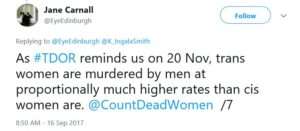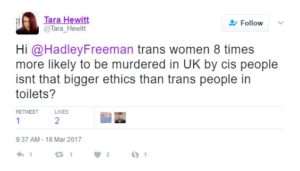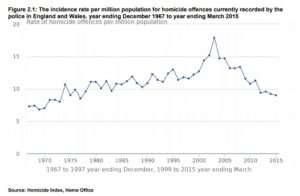There’s no evidence trans people are murdered at higher rates than the general population in the UK



The Trans Murder Monitoring (TMM) Project does admirable and necessary work collecting and analysing reports of homicides of trans and gender-diverse people worldwide. Individual countries’ trans homicide reports vary widely, with the UK thankfully recording incidences that are much lower than the highest incidences in some countries in Central and South America. This post aims to examine the claim often made that trans people are at higher risk of being murdered than non-trans people, and looks at whether there is any evidence of this in the UK, specifically.
During the decade covered by the TMM project (2008 – 2016) + 2017 (as at November 2017), a total of 7 trans homicides are known to have occurred in the UK; all were perpetrated in England. All victims were males who identified as trans women (or males who sometimes cross-dressed) and were killed by men. Please see this post for a more in-depth look at those specific homicides.
To work out whether trans people are at higher risk of of being murdered in the UK than the general population, we need to be able to compare rates of homicide between the two groups; it matters very much whether those homicides were among say, a thousand people or a million people.
The UK Home Office publishes homicide incidence rates per million population in England & Wales annually, and (again, thankfully) these rates are among the lowest in the world with continuing statistically significant reductions in recent years. (The peak in 2003 on the below graph is from the inclusion of 172 victims of Harold Shipman).

Source: Homicide Index
Taking an average for a similar period which the TMM report covers (i.e. averaging Homicide Index rates for 2008-2015 + 2016 rate) we find that
- The average homicide rate between 2008-2016 for England & Wales is 10.47 homicides per million population
This rate of ~10 homicides per million is consistent across the UK and the vast majority of murders (94%) are committed by men. Males are also more likely to be victims of homicide than females e.g. in 2016 the homicide rate for males was more than twice that for females though the overall rate for that year works out as 9.9 per million population.
In order to be able to compare rates of homicides between trans and non-trans people in the UK, we need to have an idea of the size of the trans population. The UK government currently estimates that 650,000 people (1% of the UK population) are “likely to be gender incongruent to some degree”; this estimate was provided by GIRES and was included in the Transgender Equality Report. This is a high estimate and presumably includes anyone from people who have actually transitioned to people who might cross-dress occasionally. GIRES has also estimated that 0.2% of the population (i.e. 130,000 people) are trans and “will seek medical treatment for their condition at some stage” and since the introduction of Gender Recognition Certificates (GRCs) in 2005, there have been 4,556 GRCs issued. Elsewhere in the world, trans people are estimated to be anywhere from 0.1% up to 1% of the population; in the USA, the Williams Institute estimated that 0.6% of the population identified as transgender in 2016.
So, assuming there are somewhere between 650,000 “gender incongruent to some degree” people [high estimate] and 130,000 trans people who “will seek medical treatment for their condition at some stage” [low estimate] in the UK, comparable trans homicide rates per million population can be estimated using an annual average of 0.7 trans homicides per year (7 homicides between 2008 and 2017, is 0.7 per year).
- 0.7 homicides among ~650,000 people is approximately 1 per million population for trans homicides
- 0.7 homicides among ~130,000 people is therefore around 5 per million population for trans homicides
These crude, estimated figures would appear to indicate that the homicide rate among both a high and a low population estimate of UK trans people is lower than the 10 per million homicide rate for the general population of England & Wales. The trans homicide rate appears to be one tenth of the general homicide rate if we assume 1% of the population is trans, or half the rate if 0.2% of the population is trans.
In this post, the Fairplay For Women team compared homicide rates using absolute numbers of homicides in the trans population vs the general population during the same period and arrived at a similar conclusion. They also include some useful comparisons of trans homicide rates in different parts of the world.
But these estimates of the homicide rate don’t take into account whether there are trans homicides we don’t know about and aren’t documented in the TMM project, or indeed whether those trans population estimates are a) accurate or b) constant at ~1% (or 0.2%) of the population over the decade.
Looking at it a different way, what happens if we assume that 1% of the 500-600 homicides that occur in England & Wales each year were, in fact, trans homicides. So if 650,000 (1%) of the population is transgender, therefore we should expect there to be 5 or 6 homicides of trans people every year, rather than the observed 0.7 per year.
A couple of lines of thought follow from this
- For the trans homicide rate to be higher than in the general population, that 5 or 6 (rather than 0.7) per year homicide count would also have to be higher (i.e. 5 or 6 trans homicides a year would just reflect a similar homicide rate as the general population)
- How likely is it in today’s febrile media climate that every year for the past decade at least 5, possibly more, homicides of trans people have been ‘invisible’ i.e. not revealed in the course of a police investigation, post-mortem, inquest or media coverage, and therefore added to the TMM project?
If the numbers don’t add up, which numbers are likely to be wrong? What do we still not know?
The low observed numbers of trans homicides must therefore indicate that either:
- Many such homicides are consistently not being recorded or reported (i.e. we need better data collection); or
- Trans people are for some reason murdered less often than the general population in the UK; or
- The estimated 1% (650,000) of the UK population is not correct (i.e. the observed 0.7 homicides/year incidence can only reflect even a similar homicide rate as the general population if the trans population is smaller than estimated)
So in order to accurately monitor the homicide rate in the trans population we need better collection of homicide data and we also need an accurate estimate of the trans population in the UK; ironically, the census would be a logical way to achieve this. Without these data we cannot properly compare or monitor the trans homicide rates with the rate in the general population, much less conclude that it is higher.
Furthermore, as homicide rates in the general population are higher for males vs females we also need an accurate sex ratio for the trans population to be able to compare like-for-like rates, particularly as all 7 trans homicides recorded in the past decade were of males who identified as transgender.
In conclusion, there’s currently no evidence that trans people in the UK are at higher risk of homicide than the general population, and some indication that the risk may well be lower. Without this evidence, it serves absolutely no purpose to assert otherwise, other than to needlessly frighten and curtail the lives of trans people who often face prejudice and discrimination, still, in 2017.
Further reading:
Homicide Rates of Transgender Individuals in the United States: 2010-2014. Dinno A. Am J Public Health. 2017 Sep;107(9):1441-1447
This paper concludes “The overall homicide rate of transgender individuals was likely to be less than that of cisgender [i.e. non-trans] individuals”. However in certain subgroups (Black/Latinx males identifying as trans women) the risk was higher.
Link to full text of the paper

One thought on “There’s no evidence trans people are murdered at higher rates than the general population in the UK”
Comments are closed.